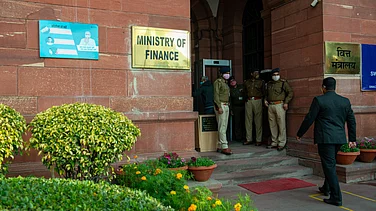In Kautilyanomics For Modern Times (2022), author and economist Sriram Balasubramanian had delved deep into the period when Kautilya wrote his Arthashastra and focused on sustainable wealth creation. Now, in his second book (part of a trilogy), titled Dharmanomics, Balasubramanian argues for Dharmic capitalism as an anecdote to the ills of profit-obsession among companies and unnecessary state intervention.
In an interview with Outlook Business, Balasubramanian describes how he came upon the idea of Dharmic capitalism and how the idea can help create businesses that sustain beyond immediate political contexts.
Kautilyanomics, your first book of a trilogy, revives the teachings of Kautilya and emphasises its relevance today. What inspired you to write about ancient Indian srenis?
In Kautilyanomics I present a concept called Dharmic capitalism. The concept argues that Kautilya’s economic philosophy looked beyond the state and the market with Dharma at its foundation. In my opinion, the definition of Dharma encompasses ethics, responsibilities and harmony with the world.
Kautilya’s teachings promote a strong non-micromanaging state, wealth creation via a global outlook and sustainable growth and welfare. In Dharmanomics, I contextualise some of these ideas in the Bharatiya economy per se.
I see various iterations of Dharma-based economic frameworks in common era kingdoms such as Cholas, Pallavas, Pandavas, Vijayanagar and Kambuja Desa. In the book, I argue that the Dharmic ecosystem and srenis played a crucial role in economic prosperity.
Srenis were ancient entities that were an amalgamation of [what today are] multinational corporations and industry bodies, like Ficci.
These have been in existence for thousands of years. They were underpinned by the philosophy of dharma, had democratic governance mechanisms and were very similar to modern-day corporations. These srenis survived thousands of years irrespective of which king was ruling.
In the book, I argue that some of the principles that governed these srenis are implicitly part of the corporations of today, since most of the top corporations are offshoots of the Dharmic ‘way of life’ that has permeated through thousands of years.
Given that top companies are family-driven enterprises, these principles are built into their decision-making process. I merely highlight this in an explicit manner and argue that some of the principles need to be nurtured for sustained corporate governance and success.
In the book, you highlight the significance of temples in making kingdoms prosperous, starting from the Saraswati-Sindhu civilisation. You have drawn parallels with the Ram Mandir in Ayodhya. How relevant is the temple-based economic model in today’s technology-centred world?
A 100% relevant. If there is one decentralised institution that is the economic engine of Bharat’s villages, it is the temple and the Dharmic ecosystem around it. One needs to view the temple as an economic institution rather than merely a socio-religious institution.
The Dharmic ecosystem around the temple provides a huge economic opportunity. In simple terms, the kiranas that develop, the tourism that develops, the infrastructure that gets created as an extension of the demand from the temple is part of the economic churn in villages.
This demand is inelastic and does not depend on the macroeconomic environment.
If one were to aim for inclusive and decentralised economic prosperity, especially in Tier-II and Tier-III cities, there is a strong case for a coordinated effort to expand the pie.
The Americans made the university town-based economic model in the 1990s to promote decentralised growth. While we should aspire for such university-based towns for prosperity, if we already have a flourishing physical system thriving, why not make use of it in a calibrated manner to achieve larger economic goals?
Despite technology permeating our lives, as individuals we still have to make economic choices based on our ‘way of life’. That hasn’t changed in a thousand years. Policymaking has to be aligned to our ‘way of life’ rather than the other way around.
In your book, you compare srenis or guilds in ancient India with modern-day corporations. One crucial difference you point out is that while srenis followed the principles of Dharmic capitalism, corporations are largely profit-driven. Do you think principles of Dharmic capitalism can be adopted by the Indian economy?
The srenis were independent entities without state interference and governed through a democratic process based on ethics and responsibilities. They were also very egalitarian in a sense that they had members across caste, creed and other denominations, including foreign nationals (Jews, for example) who were part of these entities.
The focus on ‘harmony’ ensured they were open, inclusive and engaged with the rest of the world in a very proficient manner.
The most important attribute of srenis existing and thriving irrespective of state allegiance or those in power provides important lessons for businesses today. It provides an incentive for them to look beyond the state and make them indispensable in the commercial space underpinned by Dharmic principles and values.
Srenis as trade associations were so strong that it was impractical for an individual trader to compete against them. What role did the state play in protecting small traders?
In Kautilya’s Arthashastra, one of the consistent themes is the avoidance of Matsyanyaya—the principle by which the big fish eat the small. In modern parlance, that would translate to avoiding moral hazard at the marketplace.
Kautilya advocates for a strict implementation of law and order and fair/equitable platforms for small traders to function properly. Then there were grants and incentives for small businesses.
Temples served as a sort of venture capital (VC) funds that encouraged small entrepreneurs with reasonable credit lines.
Finally, because most srenis were underpinned by the Dharmic fabric, they also saw it as their Dharmic duty to protect smaller entities. They saw a bigger purpose than mere obsession with profits.
Apart from the principles of Dharmic capitalism, you talk about the role played by kings. But the form of government has changed from monarchy. In a modern democracy, where the head of the state changes every five years, how will the principles of Dharmic capitalism sustain?
I think the ideas of Dharmic capitalism are even more relevant in a democratic system. In the past, the economy thrived regardless of who was in power. That remains relevant today.
Imagine if we can have an economic system that thrives irrespective of who is in power. This negates the disadvantages of political intervention in economic outcomes.
Corporations and business entities need to have the agility to deal with various political entities and yet remain successful. Dharma-based economic and business frameworks provide corporations greater agility to deal with challenges of the modern democratic setup.
Western capitalism rests on the idea of the free market economy. Dharmic capitalism, on the other hand, is more state regulated within a temple-based economy. After liberalisation, India has become a more free market-oriented economy. Can Kautilyan Dharmic Capitalism work in such a context?
Kautilyan Dharmic capitalism is bound by the philosophy of Dharma which is beyond the state-market binary. It provides a sound foundation for both the state and the market to function.
Even before economic liberalisation, for thousands of years the role of the state was limited. In that sense, there is no big structural difference between the economic structure after liberalisation in the 1990s and the one in the past. In that sense, I would look at the first principles that Dharmic frameworks provide and see their importance today. Of course not everything from the past is sacrosanct. We need to choose what is relevant today.



























